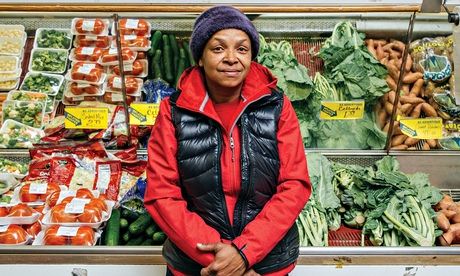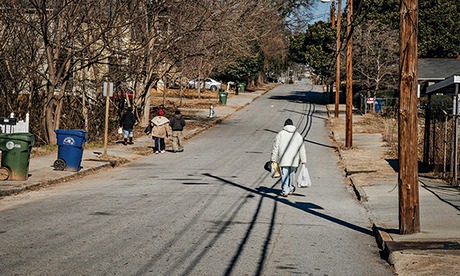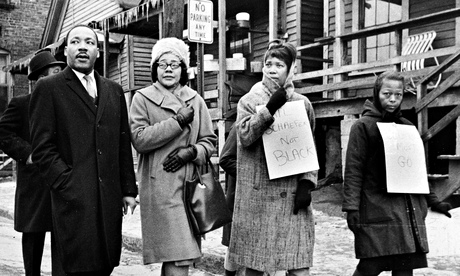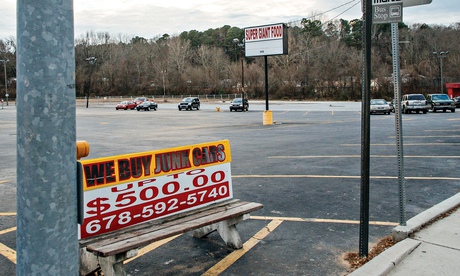In most of the world's densely packed urban areas, you can pick up fresh produce at a stall on the way home from work or buy bread, meat and staples at the cornershop across the street. But in sprawling metroAtlanta, where the model is megamarkets surrounded by mega parking lots, few of us have the option of a quick dash to the store.
 Cassandra Norris, manager of Shoppers Supermarket. Photograph: Audra Melton/Atlanta Magazine
Cassandra Norris, manager of Shoppers Supermarket. Photograph: Audra Melton/Atlanta Magazine
 People walking with food shopping in Atlanta Photograph: Audra Melton
People walking with food shopping in Atlanta Photograph: Audra Melton
 Martin Luther King Jr next to his wife, Coretta, as they join activists during a tour of Vine City, in 1966. The area was then a slum which King described as appalling. The Atlanta district's Walmart now sits on Martin Luther King Jr Drive. Photograph: AP
Martin Luther King Jr next to his wife, Coretta, as they join activists during a tour of Vine City, in 1966. The area was then a slum which King described as appalling. The Atlanta district's Walmart now sits on Martin Luther King Jr Drive. Photograph: AP
 Stores like Super Giant Food are often the only one around for miles: many customers travel an hour or more by bus. Photograph: Audra Melton/Atlanta Magazine
Stores like Super Giant Food are often the only one around for miles: many customers travel an hour or more by bus. Photograph: Audra Melton/Atlanta Magazine
Source: theguardian.com/
Author: Rebecca Burns
When you're trying to figure out what to fix your young children for dinner and you realise you need milk and eggs and a bag of salad greens and chicken breasts, and you have no choice but to load everyone in the minivan and drive five miles through traffic to get to the store, you're feeling the impact of US development patterns that have made Atlanta the third-worst urban food desert in the country (behind only New Orleans and Chicago).
Living in a food desert doesn't just make it tough to get your daily servings of fruit and vegetables. A 2011 Food Trust geographic analysis of income, access to grocery stores and morbidity rates concluded that people who live in metropolitan Atlanta food deserts are more likely to die from nutrition-related sicknesses like diabetes and heart disease.
In Atlanta, the ninth-biggest metropolis of the world's richest country, thousands of people can't get fresh food, and some are getting sick as a result. Which raises a simple question: why can we build multimillion-dollar highway systems and multibillion-dollar stadiums, but not more grocery stores? If we can build a museum dedicated to a soft drink and one that celebrates college football and another that trumpets civil rights, can't we help our neighbours with what seems to be a most essential and basic right: putting an affordable and healthy dinner on the table?
When you talk about Atlanta's food deserts, you have to talk about the three themes entwined in every civic issue in this region: race, class and sprawl. The fact is, food deserts are more prevalent in non-white neighbourhoods. In poor communities, food is more expensive and there are fewer healthy options. Ironically, much of the local produce prized by the city's finest chefs is grown in urban farms in poor neighbourhoods – produce that is often trucked across town to farmers markets in wealthier enclaves. But of all the factors that contribute to Atlanta's food-desert problem, none is more important than transportation. Our low population density combined with a lack of comprehensive public transit means many people simply cannot get to places where fresh food is available.
So many people, so few stores

Atlanta's west side, with its stark contrasts of wealth and poverty, is a microcosm of the region's food desert dilemma. The communities near the Georgia Dome, home of the Atlanta Falcons NFL team, are served by one supermarket (Walmart), one well stocked small store (Shoppers Supermarket), and at least 60 convenience stores that carry little but packaged snacks.
When it moved into Vine City a year ago, Walmart retrofitted and expanded space that had been left vacant when a Publix supermarket moved out of the neighborhood in 2009. Walmart created a scaled-down version of its suburban supercentres – 75,000 sq ft versus 200,000; 13 checkout lanes versus 30.
Ivory Young, who has represented the Vine City area on the Atlanta city council since 2001, said that after Publix decamped, the city approached Walmart and the retailer initially said no. He said: "But they did their own analysis and came to find they were wrong; the community would support it." More than 30,000 people shop here weekly, and while they buy paper towels and bleach and other household products, the store's biggest category is groceries. The top sellers: tilapia, bananas, strawberries (when they're in season) and chicken leg quarters.
The Vine City Walmart is located on Martin Luther King Jr Drive, two blocks from the King family's former redbrick home at 234 Sunset Avenue. When they moved there in the mid-1960s, it was easy to shop for groceries; even though Atlanta's sprawl to the suburbs had started, most people still lived in town and walked to well-stocked corner stores or shopped at small groceries near bus routes. (Not that the area didn't have its problems. In 1966, King and Ralph David Abernathy joined protests that highlighted the living conditions in Vine City: rat-infested houses owned by slumlords, boarded storefronts, no parks or playgrounds.)

But over the past half century, most of Vine City's minimarkets have scaled back or shuttered completely. They lost customers with the flight of middle-class Atlantans – white and black – to the suburbs. Consolidation in the industry meant suppliers began servicing just big suburban chain stores. But one throwback remains: Shoppers Supermarket, tucked into Simpson Plaza, a 1963 shopping centre that is a five-minute walk from the Kings' former home.
From the outside, Shoppers Supermarket does not appear particularly promising. Day in and out, men cluster on the sidewalk in front of the laundry next door, smoking and tossing dice. The storefront is dingy, the sign askew, the doors barricaded by thick burglar bars. But inside, the cases are stocked with fresh meat, fruits, and vegetables, a rare sight among corner stores, where refrigeration units are barren or used to store nonperishables. (I visited one store in Summerhill where produce coolers held hair weaves.)
Cassandra Norris has worked here since 1983 and has been store manager for two decades, a steady presence through three ownership changes (the present owners, Joo Ho and Sunhwa Song, bought Simpson Plaza in 1995 for $465,000). Norris grew up a few blocks away, graduated from Booker T Washington High School in 1978, and has watched generations of families buy groceries. "We stock things to make the older people happy," she said, gesturing toward a meat case that holds smoked meats and ham hocks ($1.49 or 89p a pound). "The younger people are the ground beef generation."
Norris said she strives to keep prices as low as possible. She drives Mrs Song's van to the state farmers' market at Forest Park to pick up all those fresh fruits and vegetables and cut out delivery fees. "I just put it all in the boss lady's van," she said.
Crunching the figures
Hard data confirms my observation that Norris runs the best-stocked little store in the area. Stephen Barrett wrote his Georgia State Universitymaster's thesis on the availability of fresh or local produce in Vine City and English Avenue.

He used an iPhone app to track shelf stock and logged 311 miles by bike as he visited 20 stores. Barrett's findings are dispiriting: half of the stores he surveyed carried zero produce. Of the other 10, most stocked only one or two types of fruit – usually apples or bananas, placed up at the cash register along with lottery tickets and cigarettes.
Shoppers Supermarket, however, stocked 17 types of vegetables and eight kinds of fruit; the only nearby store with greater selection was Walmart (97 varieties of vegetable, 45 types of fruit).
If Shoppers is the best-case scenario for corner stores, a mile down the road, Simpson Food Mart represents the norm. A neatly painted sign touts eggs, milk, groceries and sandwiches. Inside, however, the tiny store smells like smoke and echoes with the electronic clank of four video slot machines that occupy about a third of the floor space. On one of my visits there, the four black stools in front of the machines were occupied by players, while a handful of observers squeezed behind them.
The gaming area might have once held a dairy case; now the few pints of milk and cartons of eggs are stored in minifridges on a counter that also holds wrapped sandwiches.
"We don't stock any fruit or vegetables," the clerk told me when I asked if he had any apples. The closest thing resembling produce I could find in the store was a pint of Tropicana apple juice.
Obesity rates in food deserts
One of the paradoxes of food deserts is that the people living in them often have the highest rates of obesity – and its associated illnesses.
A 2009 study in the journal Pediatrics showed that children who live in neighbourhoods with lots of corner stores consume more calories and are more likely to be obese than children who live in neighborhoods with supermarkets. When King and Abernathy railed against poverty in the 1960s, many poor people were malnourished and severely underweight. Today they are still malnourished – but overweight.
A decade ago, Charles Moore, an Emory and Grady physician, analysed his patient files and found that his worst cases came from one zip code: 30314, home to Vine City and English Avenue.Moore realised that diet contributed to his patients' health problems and began to write "food prescriptions", advocating healthier eating and preventive care. In 2005 he founded the Healing Community Centre, now a full-service clinic on Martin Luther King Jr Drive.
"Instead of talking about a food desert, the better term is really 'food swamp'. There is an abundance of food, but it's not healthy or varied," Kwabena Nkromo told me. Nkromo runs a programme called Atlanta Food & Farm, which aims to connect local growers, store owners and poor neighborhoods.
"It's not a lack of food; it's a lack of good food," he said. Nkromo studied agriculture and economic development at Tuskegee and Clemson; he presumed that he'd work on famine relief in Africa or some other developing region of the world. He did not imagine that he'd be working on urban farm policies in the American south.
Nkromo's work underscores another paradox of food deserts, this one particular to Atlanta. While the south and west sides of the city contain some of the neighborhoods most starved for healthy foods, they also are home to at least a dozen urban agricultural businesses – Patchwork City Farms and Atwood Community Gardens, for instance.
There's a higher density of farms and gardens in this section of metro Atlanta – an arc across the south and west sides that has been dubbed the "fertile crescent" – than elsewhere, but many of them export their produce to other parts of town.
With the aim of keeping more of that locally grown food closer to home and using urban farms as catalysts for other economic development, Nkromo is organising a project, also called the Fertile Crescent. One of the group's pilot projects has been training teens and young adults at a west side shelter called City of Refuge to grow and harvest kale. The trendy green is slated to be processed into Queen of Kale chips – snacks sold online and in places such as the Johns Creek Whole Foods market.

The economics of colour
Previously, when the west side farms have tried to sell to their neighbours, there were "socioeconomic, cultural, and racial barriers", wrote Barrett. He surveyed 11 sites in the area and found that only one had tried to sell produce to local stores.
When it came to selling directly, some farmers and garden operators seemed confounded, for example, that locals didn't subscribe to their CSA (community supported agriculture) plans. But a CSA at Patchwork City Farms costs $450 (£270) for 18 weeks; at a weekly cost of $25, that CSA subscription would eat up most of the total allowance for a Georgia resident on food stamps – about $34 a week.
Another farm operated a full season before grasping that the reason its neighbours wouldn't come to its onsite market was that they could only get there by foot. Walking a mile to market isn't an obstacle; trekking home with a 5lb melon is.
The growers' disingenuousness was matched by suspicion on the part of locals. Some see the farms as signs of gentrification, literal landgrabbing efforts by middle class – often white – interlopers. The community garden at Lindsay Street Baptist church in English Avenue is funded by a group of donors, mostly from Buckhead, who also volunteer to plant and harvest produce. Once, when the donors arrived at the church, they were greeted by a picketer holding a sign that read, "Go home, colonialists!"
While the encounter was distressing, Lindsay Street pastor the Rev Anthony Motley said the incident underscored the need for communication and co-operation: "It's only going to happen with a real coalition – across class and colour and the rest – creating something together."
Focusing on groceries alone will never solve deep-rooted problems, Motley said. "Food is important, but what's more important is the issue of employment. We can't create a sustainable society when we are just feeding folks. People want to feed the hungry but don't want to ask why they are hungry."
Forging a consistent and logical strategy from many disparate efforts is the goal of a project called the Georgia Food Oasis. Its members include the Atlanta Community Food Bank, the American Heart Association, Georgia Organics, and the Blank Foundation. The group has a lofty goal: eradicating food deserts across the state. It's starting with a pilot, the Westside Food Oasis.
Cicely Garrett is the food bank's point of contact at the food oasis; last autumn she was appointed to the newly created and curiously titled position of food systems innovation manager. She said: "Being able to feed yourself and your family should not be a privilege in this country."
The pilot will test ideas such as mobile farm trucks, incentives for convenience stores to stock fresh foods, urban farms and wellness education. Solving the problem of our food deserts requires addressing transit and income inequality – people need to get to stores and they need to have money to buy food. Those are intractable, systemic challenges. But when it comes to the third piece of the puzzle, simply making healthy food itself more readily available, there are examples worth replicating. National retailers can change the way they operate and take a chance, as Walmart did in Vine City.
The full version of this article appeared in Atlanta magazine in March 2014. Find further reading, maps, charts and other data atatlantamagazine.com. For more photographs by Audra Melton go toaudramelton.com.
Original Article
Source: theguardian.com/
Author: Rebecca Burns

No comments:
Post a Comment